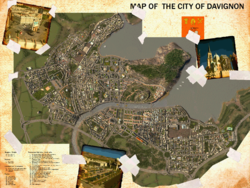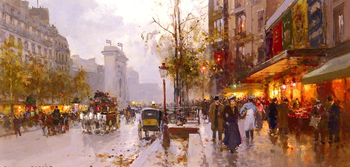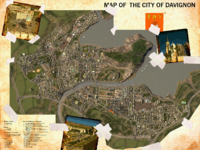Sizhecheng: Difference between revisions
No edit summary |
|||
| Line 39: | Line 39: | ||
{{Davignon districts}} | {{Davignon districts}} | ||
Latest revision as of 18:14, 27 May 2019
| Nation: | Jingdaoese Empire |
| Population: | 1,258,421 |
| Predominant language: | Southbatavian, Jingdaoese, Kildarian English |
|
| |
| Main roads: | N/A |
| Major districts: | Hertogswijck, Ouwe Molen, ... |
|
| |
| Current mayor: | |

| |
| Map versions: | N/A |
Sizhecheng or New Davignon is a city in and capital of the province Jinkeai. The city is the largest northern city within the Jingdaoese Empire. It was the centre of culture among many descendants of the Batavian immigrants, who sought to combine the Jingdaoese and Batavian culture. While it was confronted with rising pauperism during most of the early 17th century, and periodically shelled by competing forces during the Geming War, a huge fire in 1669 AN devoured most of the old city centre with its narrow streets and neglected houses. It's geographically locked in the Apollonian mountain range, making it easy to defend, while centrally located. Its location made it into an important gateway between the south and north of the country, especially at the end of the seventeenth century, when trade began to flourish once more.
History
Early history
The exact date of Sizhecheng foundation as a settlement is uncertain, as the library containing the few documents and remaining sources were destroyed by a local count in 1501 AN during a fit of rage. The lack of trustable sources makes it difficult to pinpoint a year. What is relatively certain is that the rise of Sizhecheng from a minor village to a city of importance began with the arrival of the Jingdaoese and Batavian colonists during the reign of the Haigui Emperor.
Preceding Jingdaoese annexation, the local lords - from Audente descent - of the town originally resided at the other side of the Hokubu Lake, but soon understood the strategical importance of the fishing village. According to legend, a few of the villagers - tired of fishing - went on a rampage through the valley. Its local lord saw himself confronted by an angry mob, and called together the few knights he could muster. The fishermen were no match for the trained soldiers, but retreated - together with the other villagers, who feared the fury of the nobleman - to Hama Peek. The easy to protect hilltop gave the villagers an advantage, while they could occasionally go down to the lake to fish. In the end, lord made a deal with the village elders: those villagers who had killed and raped would be punished. In return, the others were not to be hurt. The village pledged fealty to their new leaders. The Count, now ruling the valley, received the title of Count of Sizhecheng.
On Hama Peek, the Count started to construct his new residence. Its location, on the hilltop and overviewing the lake and valley, gave the Duke and the village the necessary protection from raiders. The town itself benefited from its location: it soon would dominate the mountain pass, which would bring prosperity to the formerly impoverished town.
The Jingdaoese era
The settlement grew steadily under the Audente Counts. The trade income, taxes on travelling Senyan and Kildarian merchants (most coming from the south, and curious about the 'Audente' town) and some strategical marriages led to an increase of power. While local tribes and other settlements were in a fierce rivalry over the surrounding lands and mountain ranges, Sizhecheng started to dominate. Aspirations of the Counts to crown themselves princes were thwarted by a series of military losses. In the meantime, the Jingdaoese had established themselves as de facto overlords in the region. While not formally part of the Empire, the Counts feared annexation and didn't dare angering the colonists and large Empire.
Throughout time, the Counts of Sizhecheng and new (mostly Batavian) colonists would end up in conflicts with each other several times. It wasn't until the Battle at Aireru that the Count's hegemony was broken, which meant the end of independence of the region (but it retained an enormous degree of autonomy). The city remained one of relative importance as regional capital, which would remain so until the Geming War.
Renewal program

An urban renewal program, pushed and supported by Vice-Roy Hayu and led by Adolf Perrier, was started the same year: the burned down houses and slums were erased from the earth, while survivors were moved out to temporary housing near the edge of the city. Protests immediately broke out among a part of the poor workers when news about the renewal program spread, but it was soon suppressed by the police forces. Further promises of better living conditions in the new houses and the prospect of a job (as the works would produce a demand in skilled and unskilled labour) calmed most nerves. The first construction works could begin. The Vice-Roy (who had visited the Benacian continent a few times during the reign of the Meiyo Emperor), however, envisioned more than new and clean houses: inspired by experiences at Paleys Raiselle and Tianhoucheng, he wanted to rebuild the city in a mix of Jingdaoese Batavian Renaissance style: wide boulevards, parks to relax, palaces and monuments to impress and act as meeting places for industrialists and higher classes.
The changes turned the whole social system on its head. While the lower nobility and elite had always preferred living on the countryside, to avoid the busy city, this now changed. With the impressive boulevards, several parks and beautified facades, the city centre became the favourite living space of the richer classes. The Count of Sizhecheng sought his accommodation on the Southbank (mainly in the Hereburgh), which had been the political heart of the city since the integration of Jinkeai into the Empire. Many followed his example, while the middle class went to live in the renovated older city districts around the Royal Palace.
| Zuydbank: | Florynkwartier - Hallen - Huyseken - Groene Wijk - Hereburgh |
| Noordbank: | Egmontswijk - Sinetoridistrict - Hertogswijck - Meulestede - Oude Haven - Zavel |

